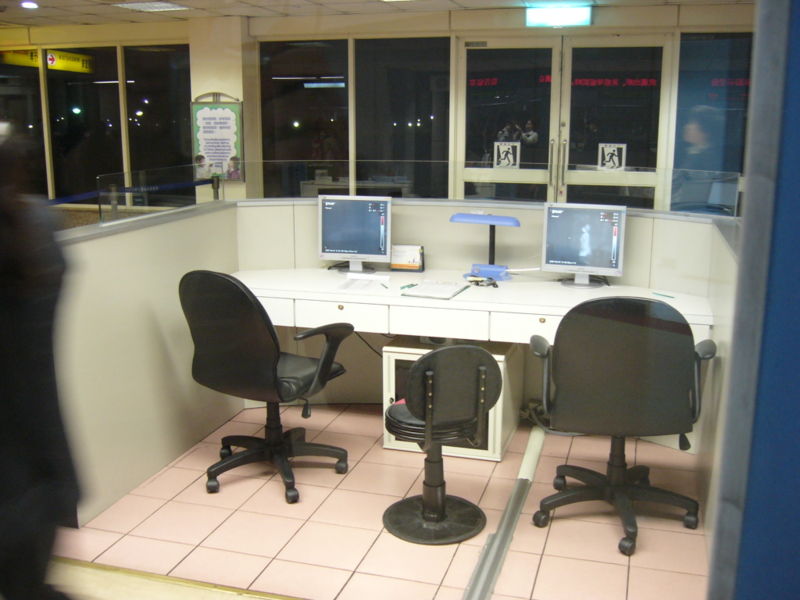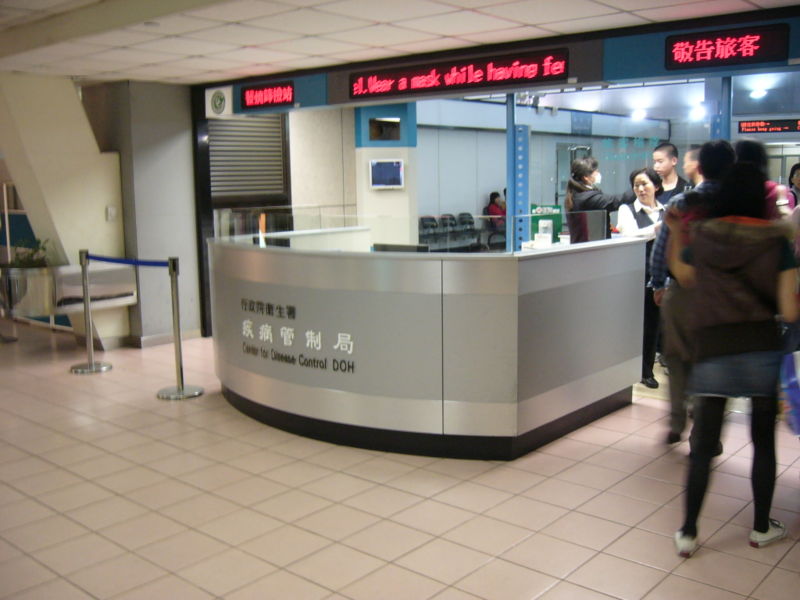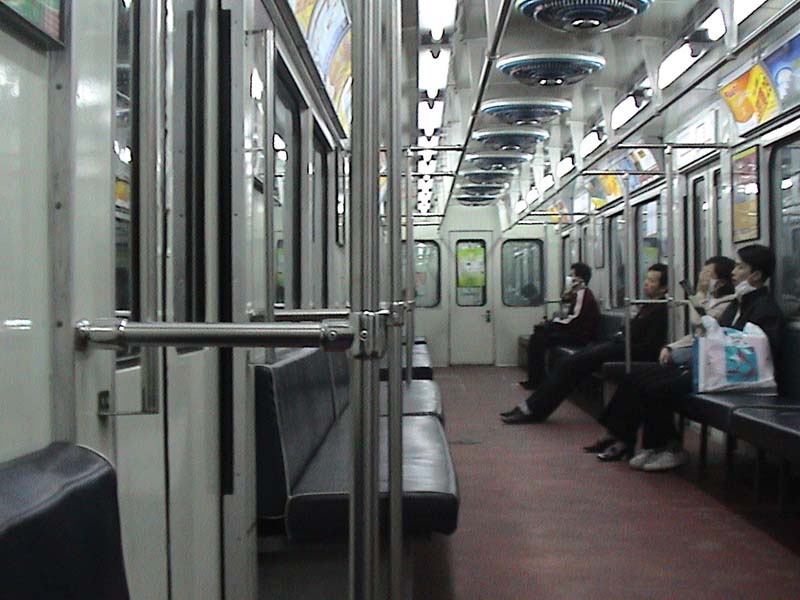Severe acute respiratory syndrome secondary prevention: Difference between revisions
No edit summary |
No edit summary |
||
| Line 9: | Line 9: | ||
WHO set up a network for doctors and researchers dealing with SARS, consisting of a secure web site to study chest [[x-ray]]s and a teleconference. | WHO set up a network for doctors and researchers dealing with SARS, consisting of a secure web site to study chest [[x-ray]]s and a teleconference. | ||
[[Image:Sars-hospital.jpg|thumb|250px|left|A SARS treating hospital in [[Taiwan]].]] | [[Image:Sars-hospital.jpg|thumb|250px|left|A SARS treating hospital in [[Taiwan]].]] | ||
<br clear="left"/> | |||
Attempts were made to control further SARS infection through the use of quarantine. Over 1200 were under quarantine in Hong Kong, while in Singapore and Taiwan, 977 and 1147 were quarantined respectively. Canada also put thousands of people under quarantine.<ref>[http://asia.news.yahoo.com/030402/3/v3tb.html Yahoo News story]. '''URL Inactive 5 July 2006'''</ref> In Singapore, schools were closed for 10 days and in Hong Kong they were closed until 21 April to contain the spread of SARS.<ref>[http://www1.moe.edu.sg/press/2003/pr20030326.htm Joint Press Release by Ministry of Education and Ministry of Health - Closure of schools], Singapore Ministry Education and Ministry of Health, 26 March 2003. URL Accessed 5 July 2006.</ref> | Attempts were made to control further SARS infection through the use of quarantine. Over 1200 were under quarantine in Hong Kong, while in Singapore and Taiwan, 977 and 1147 were quarantined respectively. Canada also put thousands of people under quarantine.<ref>[http://asia.news.yahoo.com/030402/3/v3tb.html Yahoo News story]. '''URL Inactive 5 July 2006'''</ref> In Singapore, schools were closed for 10 days and in Hong Kong they were closed until 21 April to contain the spread of SARS.<ref>[http://www1.moe.edu.sg/press/2003/pr20030326.htm Joint Press Release by Ministry of Education and Ministry of Health - Closure of schools], Singapore Ministry Education and Ministry of Health, 26 March 2003. URL Accessed 5 July 2006.</ref> | ||
| Line 17: | Line 18: | ||
On 24 March, Singapore's Ministry of Health invoked the Infectious Diseases Act, allowing for a 10-day mandatory home quarantine to be imposed on all who may have come in contact with SARS patients. SARS patients who have been discharged from hospitals are under 21 days of home quarantine, with telephone surveillance requiring them to answer the phone when randomly called up. Discharged probable SARS patients and some recovered cases of suspected SARS patients are similarly required to be home quarantined for 14 days. Security officers from Commercial and Industrial Security Corporation (CISCO), a Singaporean security company, were utilised to serve quarantine orders to their homes, and installed an electronic picture (ePIC) camera outside the doors of each contact. | On 24 March, Singapore's Ministry of Health invoked the Infectious Diseases Act, allowing for a 10-day mandatory home quarantine to be imposed on all who may have come in contact with SARS patients. SARS patients who have been discharged from hospitals are under 21 days of home quarantine, with telephone surveillance requiring them to answer the phone when randomly called up. Discharged probable SARS patients and some recovered cases of suspected SARS patients are similarly required to be home quarantined for 14 days. Security officers from Commercial and Industrial Security Corporation (CISCO), a Singaporean security company, were utilised to serve quarantine orders to their homes, and installed an electronic picture (ePIC) camera outside the doors of each contact. | ||
[[Image:8 steps towards sars prevention.jpg|thumb|200px|left|"8 Steps Towards SARS Prevention", public information poster issued by the Chinese government in 2003.]] | [[Image:8 steps towards sars prevention.jpg|thumb|200px|left|"8 Steps Towards SARS Prevention", public information poster issued by the Chinese government in 2003.]] | ||
<br clear="left"/> | |||
Sparked in particular by the publicity of an elderly gentleman who disregarded the quarantine order, flashing it to the public as he strolled to eating outlets and causing a minor exodus of patrons which persisted until the fears over the disease abated, the Singapore government called for an urgent meeting in Parliament on 24 April to amend the Infectious Disease Act and include penalties for violations, revealing at least 11 other violators of their quarantine orders. These amendments include | Sparked in particular by the publicity of an elderly gentleman who disregarded the quarantine order, flashing it to the public as he strolled to eating outlets and causing a minor exodus of patrons which persisted until the fears over the disease abated, the Singapore government called for an urgent meeting in Parliament on 24 April to amend the Infectious Disease Act and include penalties for violations, revealing at least 11 other violators of their quarantine orders. These amendments include | ||
* The requirement of suspected persons of infectious diseases to be brought to designated treatment centres, and the prohibition of them from going to public places, | * The requirement of suspected persons of infectious diseases to be brought to designated treatment centres, and the prohibition of them from going to public places, | ||
| Line 31: | Line 33: | ||
[[Image:Tauyuan SARS Checkpoint 1.jpg|left|250px|thumbnail|SARS checkpoint at Taoyuan Airport's International Arrivals in Terminal 1.]] | [[Image:Tauyuan SARS Checkpoint 1.jpg|left|250px|thumbnail|SARS checkpoint at Taoyuan Airport's International Arrivals in Terminal 1.]] | ||
<br clear="left"/> | |||
[[Image:Taoyuan Airport Thermal SARS.jpg|left|250px|thumbnail|Thermal imaging at above checkpoint.]] | [[Image:Taoyuan Airport Thermal SARS.jpg|left|250px|thumbnail|Thermal imaging at above checkpoint.]] | ||
<br clear="left"/> | |||
Taiwan Taoyuan International Airport (Chiang Kai-shek international Airport) also added SARS checkpoints with an infrared screening system similar to Singapore's Changi Airport. | Taiwan Taoyuan International Airport (Chiang Kai-shek international Airport) also added SARS checkpoints with an infrared screening system similar to Singapore's Changi Airport. | ||
[[Image:Rapid transit in Beijing.jpg|left|240px|thumbnail|The Beijing Subway system is usually crowded, but during the SARS outbreak, only five people can be seen inside this subway car. (May 11 2003)]] | [[Image:Rapid transit in Beijing.jpg|left|240px|thumbnail|The Beijing Subway system is usually crowded, but during the SARS outbreak, only five people can be seen inside this subway car. (May 11 2003)]] | ||
<br clear="left"/> | |||
==References== | ==References== | ||
Revision as of 14:47, 24 September 2012
|
Severe Acute Respiratory Syndrome Microchapters |
|
Differentiating Severe Acute Respiratory Syndrome from other Diseases |
|---|
|
Diagnosis |
|
Treatment |
|
Case Studies |
|
Severe acute respiratory syndrome secondary prevention On the Web |
|
American Roentgen Ray Society Images of Severe acute respiratory syndrome secondary prevention |
|
FDA on Severe acute respiratory syndrome secondary prevention |
|
CDC on Severe acute respiratory syndrome secondary prevention |
|
Severe acute respiratory syndrome secondary prevention in the news |
|
Blogs on Severe acute respiratory syndrome secondary prevention |
|
Directions to Hospitals Treating Severe acute respiratory syndrome |
|
Risk calculators and risk factors for Severe acute respiratory syndrome secondary prevention |
Editor-In-Chief: C. Michael Gibson, M.S., M.D. [1]
Overview
Secondary Prevention
Action implemented to restrict the outbreak of SARS
WHO set up a network for doctors and researchers dealing with SARS, consisting of a secure web site to study chest x-rays and a teleconference.

Attempts were made to control further SARS infection through the use of quarantine. Over 1200 were under quarantine in Hong Kong, while in Singapore and Taiwan, 977 and 1147 were quarantined respectively. Canada also put thousands of people under quarantine.[1] In Singapore, schools were closed for 10 days and in Hong Kong they were closed until 21 April to contain the spread of SARS.[2]
On March 27, 2003, the WHO recommended the screening of airline passengers for the symptoms of SARS.[3]
In Singapore, a single hospital, Tan Tock Seng Hospital, was designated as the sole treatment and isolation centre for all confirmed and probable cases of the disease on 22 March. Subsequently, all hospitals implemented measures whereby all staff members were required to submit to temperature checks twice a day, visitorship was restricted only to pediatric, obstetric and selected other patients, and even then, only one person may visit at a time. To overcome this inconvenience, videoconferencing was utilised. A dedicated phoneline was designated to report SARS cases, whereupon a private ambulance service was dispatched to transport them to Tan Tock Seng Hospital.
On 24 March, Singapore's Ministry of Health invoked the Infectious Diseases Act, allowing for a 10-day mandatory home quarantine to be imposed on all who may have come in contact with SARS patients. SARS patients who have been discharged from hospitals are under 21 days of home quarantine, with telephone surveillance requiring them to answer the phone when randomly called up. Discharged probable SARS patients and some recovered cases of suspected SARS patients are similarly required to be home quarantined for 14 days. Security officers from Commercial and Industrial Security Corporation (CISCO), a Singaporean security company, were utilised to serve quarantine orders to their homes, and installed an electronic picture (ePIC) camera outside the doors of each contact.

Sparked in particular by the publicity of an elderly gentleman who disregarded the quarantine order, flashing it to the public as he strolled to eating outlets and causing a minor exodus of patrons which persisted until the fears over the disease abated, the Singapore government called for an urgent meeting in Parliament on 24 April to amend the Infectious Disease Act and include penalties for violations, revealing at least 11 other violators of their quarantine orders. These amendments include
- The requirement of suspected persons of infectious diseases to be brought to designated treatment centres, and the prohibition of them from going to public places,
- The designation of contaminated areas and the restriction of access to them, and the destruction of suspected sources of infection,
- To introduce the possibility of affixing offenders who break home quarantine with electronic wrist tags (persons who fail to be contacted three times by phone consecutively will be slapped with the tag), and the imposition of fines without court trial,
- The capability to charge repeated offenders in court which may lead to imprisonment,
- And the prosecution of anyone caught lying to health officials about their travel to SARS-affected areas or contacts with SARS patients.
On 23 April the WHO advised against all but essential travel to Toronto, noting that a small number of persons from Toronto appear to have "exported" SARS to other parts of the world. Toronto public health officials noted that only one of the supposedly exported cases had been diagnosed as SARS and that new SARS cases in Toronto were originating only in hospitals. Nevertheless, the WHO advisory was immediately followed by similar advisories by several governments to their citizens. On 29 April WHO announced that the advisory would be withdrawn on 30 April. Toronto tourism suffered as a result of the WHO advisory, prompting The Rolling Stones and others to organize the massive Molson Canadian Rocks for Toronto concert, commonly known as SARSstock, to revitalize the city's tourism trade.
Also on 23 April, Singapore instituted thermal imaging scans to screen all passengers departing Singapore from Singapore Changi Airport. It also stepped up screening of travelers at its Woodlands and Tuas checkpoints with Malaysia. Singapore had previously implemented this screening method for incoming passengers from other SARS affected areas but will move to include all travelers into and out of Singapore by mid to late May.
In addition, students and teachers in Singapore were issued with free personal oral digital thermometers. Students took their temperatures daily; usually two or three times a day, but the temperature-taking exercises were suspended with the waning of the outbreak.


Taiwan Taoyuan International Airport (Chiang Kai-shek international Airport) also added SARS checkpoints with an infrared screening system similar to Singapore's Changi Airport.

References
- ↑ Yahoo News story. URL Inactive 5 July 2006
- ↑ Joint Press Release by Ministry of Education and Ministry of Health - Closure of schools, Singapore Ministry Education and Ministry of Health, 26 March 2003. URL Accessed 5 July 2006.
- ↑ Update 11 - WHO recommends new measures to prevent travel-related spread of SARS, World Health Organization, 27 March 2003. URL Accessed 5 July 2006.